Wavyleaf Basketgrass
A New Forest Invader in Maryland
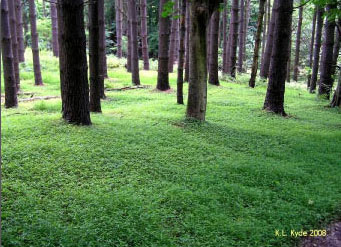 This Asian grass was first discovered growing in small patches in Patapsco Valley State Park in the 1990s. Scientists don’t know how it arrived here, but within a decade, it had spread to cover thousands of acres on public and private land in both Maryland and Virginia, the only two states where it has been documented. Ecologists believe that wavyleaf basketgrass could become even more widespread and damaging than Japanese stiltgrass, with which it shares habitats. DNR and its partners are working to reduce this spread by controlling the invader in newly discovered locations. You can help by reporting any place you see it using the
Mid-Atlantic Early Detection Network (MAEDN) mobile app.
This Asian grass was first discovered growing in small patches in Patapsco Valley State Park in the 1990s. Scientists don’t know how it arrived here, but within a decade, it had spread to cover thousands of acres on public and private land in both Maryland and Virginia, the only two states where it has been documented. Ecologists believe that wavyleaf basketgrass could become even more widespread and damaging than Japanese stiltgrass, with which it shares habitats. DNR and its partners are working to reduce this spread by controlling the invader in newly discovered locations. You can help by reporting any place you see it using the
Mid-Atlantic Early Detection Network (MAEDN) mobile app.
What Does It Look Like?
Left to Right: Japanese stiltgrass, wavyleaf basketgrass, small carpetgrass (or hairy joint grass)
Below are details about wavyleaf basketgrass and some similar plants it is often confused with.
Wavyleaf basketgrass
Non-Native
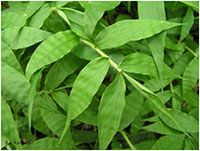 Leaves
Leaves
Up to 4" long, dark bluish-green, with distinct ripples like unfolded pleats across width of the blade and long tapering tip; leaf base touches the stem, but does not clasp it, sheaths of leaves fuzzy
Stems
Plants perennial; Overall plant height usually under 18"; branching from base with long, trailing stems (stolons) that root at nodes. Noticeably hairy with white hairs 1/8" long
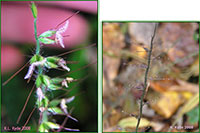 Flowers and Seeds
Flowers and Seeds
Bloom period begins in mid-July and fruiting continues well into November. Flowers occur at the ends of branches, about 4" branched panicles; feathery white stigmas (pollen-receiving organs) clearly visible; seeds occur in 3-5 pairs of spikelets; each armed with a 1/2" awn or bristle that becomes sticky in the fall, facilitating long-distance dispersal.
Japanese stiltgrass
Non-Native
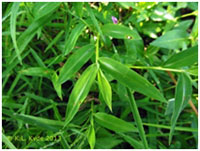 Leaves
Leaves
"2-3" long; bright, spring green bluntly narrowed at both ends, without hairs along the edges; line of silvery hairs down the midrib that appears like a white stripe; midrib not in exact center of leaf blade but off to one side
Stems
Plants annual; can grow to 3' tall, but often bend to the ground and root at nodes; stems smooth, hairs when present only at the tops of the leaf sheaths
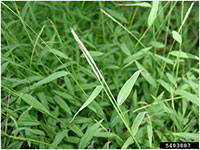 Flowers and Seeds
Flowers and Seeds
Bloom period begins in late August; fruiting continues into early October; small branched clusters of seeds at the ends of upright or reclining stems.
Small carpetgrass
Non-Native
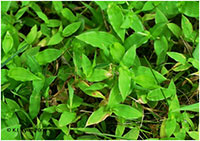 Leaves
Leaves
Leaf blade up to about 2" long; tapering to a blunt point; bright yellow-green; hairy along edges and with edges ruffled or wavy but no pleats across the face of the blade; leaves clasp the stem
Stems
Annuals up to 2' but generally under 1' tall, branched, often bending over and rooting at the nodes, sparsely hairy
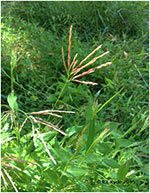 Flowers and Seeds
Flowers and Seeds
Open broomlike cluster of seeds closely spaced along "fingers."
Deer Tongue
Native
 Leaves
Leaves
May be 6 or more inches long, dark green, sheaths noticeably hairy, but leaf blades smooth, 0.5" to 1.5" wide; leaf sheaths constricted at top and leaf blades appear to clasp the stem
Stems
Substantial perennial plant up to 4' tall, with thick underground stems (rhizomes)
 Flowers and Seeds
Flowers and Seeds
Delicate, airy, open-branched panicles at the ends of the stems, giving the appearance of miniature Christmas trees in overall shape .
Wavyleaf basketgrass and Japanese stiltgrass often grow together in the same moist mixed hardwood forests. They can be told apart easily if you look closely.
How Can You Help?
- Learn to recognize this grass and help other people learn it.
- Remove it from your property. It has weak roots and can easily be pulled out by hand, or it can be treated with an appropriate herbicide.
- DO NOT walk through patches of the grass during the fall, when the awns are sticky and you can carry the seed with you by mistake and spread the grass. Your dog can pick up the seeds too.
- Report infestations to the national mapping project through the
Early Detection and Distribution Mapping System (EDDMapS) online or the mobile application
MAEDN.
Acknowledgements:
Japanese stiltgrass Flowers & Seeds, Photo by Leslie J. Mehrhoff, University of Connecticut, Bugwood.org
Deer tongue Flowers and Seeds, photo by Tom Potterfield Flickr CC BY-NC-SA 2.0
All other photos courtesy of Kerrie Kyde